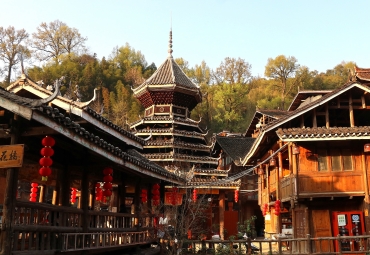A city that continues to prosper in urbanization
The word "home" can mean many things. To me, wherever you are and whoever is with you is home. I am so proud and grateful that I call Guiyang home.
When people ask me what makes Guiyang so special, I tell them it is the people, the food, the city's urban development, and the countless opportunities that I have been so fortunate to receive.
Guiyang has developed itself as a food destination. Guizhou province is famously known for countless local dishes including spicy chicken, spring rolls, bean curd noodles and sour fish soup. There are other snacks which I enjoy such as fried pork and pork belly.
Being in Guiyang allows me to embrace the culture not just of Guiyang, but also China.
Living here for such a long time has allowed me to witness the growth and development of Guiyang.
Yet one of Guiyang's most unique features is its recent development and rapid urbanization.
Roads that circle around mountains rather than go in straight lines, houses crammed together instead of planned into organized communities, the city's core represents a typical example of quick population growth.
In contrast, Guanshanhu, the northwest district of the city, is a picture-perfect vision of urban planning.
With structured roads going in direct paths, massive parks in central areas, a clear business district, and obvious residential areas, Jinyang presents itself as a highly developed modern city with clear urban planning.
Having both features so strikingly clear in one city is not common. Together, they provide multiple attractions for outsiders looking to visit or live in the city.
Another aspect that has intrigued me is transportation. When I first arrived here, there was no subway system.
It was under construction and the only way to access the city was by walking, catching the bus or taking a taxi.
This caused a lot of traffic congestion on the roads and delays when trying to move around to different districts and areas. In 2018, the first subway line opened to make the city more accessible to other areas.
Then in 2021, the second line opened to connect the city with the airport in the outskirts of Guiyang. The third line is now under construction, and it is going to make Guiyang even more accessible.
Another impressive aspect of Guiyang's development was its offering and growth of international flights to many countries prior to the pandemic.
This made me feel that Guiyang was on track to becoming an international city, making its presence known along with other international cities such as Shenzhen, Shanghai, Guangzhou and Chengdu.
With the growth of big data, I can only imagine Guiyang will attract more people from other countries and the demand to access Guiyang directly will only continue to grow.
Furthermore, Guiyang's location in China makes it very accessible to other cities by way of high-speed rail. Many big cities, such as Chengdu, Chongqing, Guangzhou, Shenzhen, Wuhan, and Guilin are just a few hours away.
Many people prefer to live in historic, bustling areas of a city where they can absorb and experience as much of the culture as possible. On the other hand, some prefer quieter and more modern urban environments.
Guiyang allows people to live in their environment of choice, while also having immediate access to the other, making it an ideal living location.
There has been an increase in the number of housing communities and shopping malls over the last few years, which is also evidence of Guiyang's urban development.
If you combine these features with the massive growth in big data and the tech industry, wonderfully kind and friendly local people and delicious food along with affordable living, clean air, a moderate climate, and breathtaking scenery, Guiyang, in my eyes, is the perfect place to live.
The author is currently working as an English teacher at No 1 High School in Guiyang.
All rights Reserved. 京ICP备13028878号-8







 Overview
Overview Guiyang
Guiyang Guian New Area
Guian New Area Liupanshui
Liupanshui Anshun
Anshun Qianxinan
Qianxinan Qiandongnan
Qiandongnan Qiannan
Qiannan Zunyi
Zunyi Tongren
Tongren Bijie
Bijie Guizhou commits to culture preservation and rural vitalization
Guizhou commits to culture preservation and rural vitalization Guizhou voice at 2025 national two sessions
Guizhou voice at 2025 national two sessions Meet the 'genius moms' at Shenzhen cultural fair
Meet the 'genius moms' at Shenzhen cultural fair 

